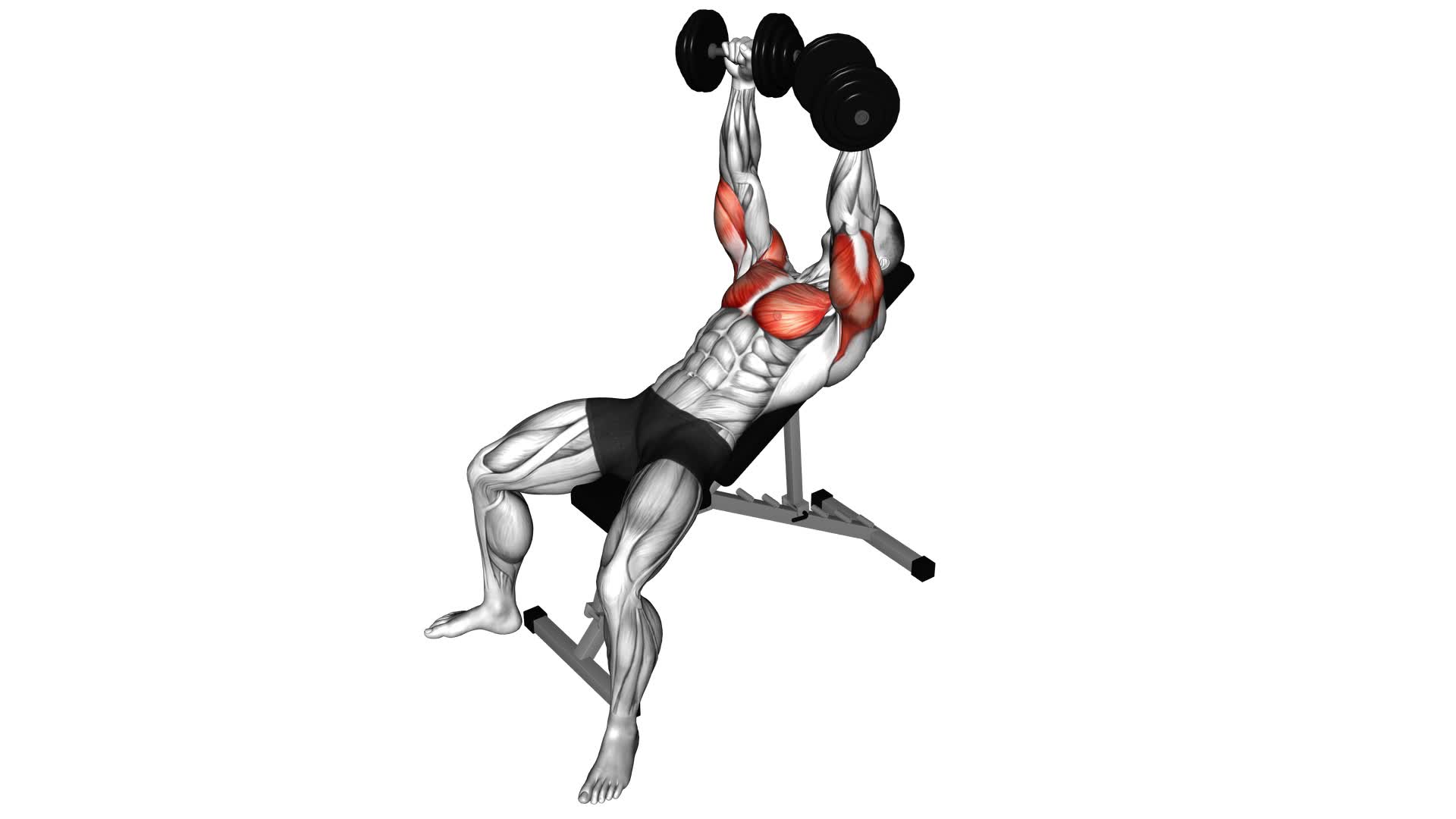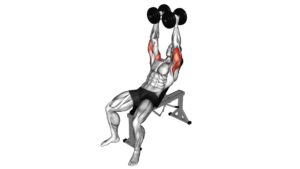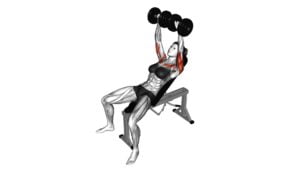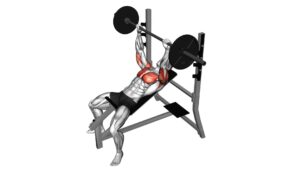Dumbbell Incline Bench Press – Video Exercise Guide & Tips

Looking to build strength and sculpt your upper body?
Watch This Exercise Video
The dumbbell incline bench press is a fantastic exercise to add to your routine.
In this video exercise guide, we will show you the proper form and technique, along with variations and progressions to keep you challenged.
Avoid common mistakes and maximize your results with our expert tips.
Get ready to take your fitness to the next level with the dumbbell incline bench press.
Key Takeaways
- Dumbbell incline bench press targets the upper chest muscles effectively.
- It engages the front deltoids for shoulder development.
- It builds triceps strength and size.
- Increasing weight, sets, and reps over time can help increase volume and improve strength and power.
Proper Form and Technique
To perform the dumbbell incline bench press with proper form and technique, position yourself on an incline bench with a dumbbell in each hand. This exercise is great for targeting your upper chest muscles, shoulders, and triceps.
However, it's important to be aware of common injuries associated with this exercise and to use the recommended weight range to avoid any potential harm.
Common injuries that can occur during the dumbbell incline bench press include shoulder impingement, rotator cuff strains, and pectoral muscle tears. To prevent these injuries, it's crucial to start with a weight that you can comfortably handle and gradually increase the weight as your strength improves. Using a weight that's too heavy can put excessive strain on your muscles and joints, leading to injury.
The recommended weight range for the dumbbell incline bench press varies depending on your fitness level and strength. As a general guideline, beginners should start with lighter weights, such as 5 to 10 pounds, and focus on mastering the proper form before progressing to heavier weights. Intermediate and advanced lifters can use weights ranging from 15 to 50 pounds or more, depending on their individual abilities.
Benefits of Dumbbell Incline Bench Press
The dumbbell incline bench press offers numerous benefits for those looking to strengthen their upper chest, shoulders, and triceps. Here are some key advantages of incorporating this exercise into your workout routine:
- Muscle Activation: The incline bench press targets the upper chest muscles, such as the pectoralis major and minor, more effectively than the flat bench press. This helps in developing a well-rounded and balanced chest.
- Shoulder Development: Performing the dumbbell incline bench press also engages the front deltoids, which are the muscles responsible for shoulder flexion. This exercise helps in strengthening and sculpting the shoulders, providing a more aesthetic appearance.
- Triceps Strength: The triceps, located at the back of the upper arm, are heavily engaged during the dumbbell incline bench press. This exercise helps in building triceps strength and size, contributing to overall arm development.
- Equipment Needed: One of the advantages of the dumbbell incline bench press is that it only requires a set of dumbbells and an incline bench. This makes it easily accessible and convenient for home workouts or gym sessions with limited equipment.
Incorporating the dumbbell incline bench press into your workout routine can help you achieve a stronger upper body, improve muscle development, and increase overall strength. Remember to maintain proper form and gradually increase the weight as you progress.
Variations and Progressions
To progress your dumbbell incline bench press, gradually increase the weight and frequency of your workouts. This will challenge your muscles and allow for continued growth and strength development. There are several progression options you can consider to keep your workouts challenging and effective.
One option is to increase the weight you use for each set. Start with a weight that allows you to perform the exercise with proper form and control, and then gradually increase the weight as you become stronger. This will help you build muscle and increase your overall strength.
Another option is to increase the number of sets and reps you perform. Start with a moderate number of sets and reps, and then gradually add more over time. This will increase the volume of your workout and provide additional stimulus for muscle growth.
Additionally, you can incorporate variations of the dumbbell incline bench press to target different muscle groups. For example, you can try performing the exercise with a neutral grip or using a single-arm variation. These variations can help to engage different muscles and prevent plateaus in your training.
Common Mistakes to Avoid
Avoid these common mistakes to ensure proper form and maximize the effectiveness of your dumbbell incline bench press:
- Using too much weight: One of the most common mistakes is trying to lift more weight than you can handle. This not only compromises your form but also increases the risk of injury. Start with a weight that allows you to maintain proper technique throughout the exercise.
- Arching your back: It's important to keep your back flat against the bench throughout the entire movement. Arching your back not only reduces the effectiveness of the exercise but also puts unnecessary strain on your lower back.
- Allowing your elbows to flare out: To target the chest muscles effectively, keep your elbows slightly tucked in towards your body throughout the movement. Allowing your elbows to flare out can shift the focus onto your shoulders and increase the risk of injury.
- Neglecting the full range of motion: Make sure to lower the dumbbells until your upper arms are parallel to the floor, and then press them back up until your arms are fully extended. Neglecting the full range of motion limits the effectiveness of the exercise.
Tips for Maximizing Results
To achieve maximum results with your dumbbell incline bench press, focus on these tips.
- Pay attention to your nutrition. Eating a balanced diet that includes lean proteins, whole grains, fruits, and vegetables can provide the necessary fuel for muscle growth and recovery. Additionally, make sure to stay hydrated before, during, and after your workouts to optimize performance.
- Rest and recovery techniques are also crucial for maximizing your results. Adequate rest between sets allows your muscles to recover and prevents overtraining. Aim for 48 to 72 hours of rest between dumbbell incline bench press workouts to give your muscles time to repair and grow. Additionally, incorporating active recovery exercises, such as stretching or light cardio, on your rest days can help improve circulation and reduce muscle soreness.
- Listen to your body and adjust your workouts accordingly. If you experience any pain or discomfort during the exercise, it's essential to modify your technique or seek professional guidance. Remember, consistency is key, so make sure to follow a regular workout routine and gradually increase the weight and intensity over time.
Frequently Asked Questions
How Heavy Should the Dumbbells Be for the Incline Bench Press?
When doing the incline bench press, it's important to choose the right weight for safety and proper form.
The dumbbells should be heavy enough to challenge you, but not so heavy that you sacrifice your technique. Start with a weight that you can comfortably lift for 8-12 repetitions.
Gradually increase the weight as you get stronger. Remember to always warm up and use proper form to avoid injury.
Can the Incline Bench Press Be Performed With a Barbell Instead of Dumbbells?
Yes, the incline bench press can be performed with a barbell instead of dumbbells. This exercise targets your upper chest and shoulders, helping you develop strength and size. The barbell allows you to lift heavier weights, challenging your muscles even more.
However, using dumbbells provides a greater range of motion and activates more stabilizer muscles. Both options have their benefits, so choose the one that suits your goals and preferences.
Is It Necessary to Have a Spotter While Performing the Incline Bench Press?
When performing the incline bench press, it's important to consider whether or not you need a spotter. While having a spotter can provide added safety and support, it isn't always necessary.
The pros of having a spotter include having someone to assist with lifting heavier weights and to ensure proper form. However, some cons may include relying on someone else's availability and potentially feeling dependent.
If you prefer to work out alone, there are alternative exercises that can target your upper chest, such as the incline dumbbell fly or push-ups with elevated feet.
Can the Incline Bench Press Be Done on a Regular Flat Bench Instead of an Incline Bench?
Yes, you can do the incline bench press on a regular flat bench instead of an incline bench. However, using an incline bench offers several benefits.
It targets your upper chest muscles more effectively, helps improve shoulder stability, and allows for a greater range of motion.
If you don't have an incline bench, you can still perform variations of the incline bench press, such as using resistance bands or doing push-ups on an elevated surface.
How Often Should the Incline Bench Press Be Incorporated Into a Workout Routine for Maximum Results?
To incorporate the incline bench press into your workout routine for maximum results, it's important to find the optimal frequency.
The incline bench press targets the upper chest, shoulders, and triceps. Aim to perform this exercise 1-2 times per week, allowing for adequate rest and recovery between sessions.
This will ensure that you're effectively targeting and strengthening those muscle groups without overtraining. Remember to always use proper form and gradually increase the weight as you progress.
Conclusion
In summary, the dumbbell incline bench press is an effective exercise for targeting the upper chest muscles.
By maintaining proper form and technique, you can reap the benefits of increased strength and muscle development.
Remember to start with lighter weights and gradually progress to heavier ones to challenge yourself.
Avoid common mistakes such as using momentum or flaring the elbows.
By following these tips, you can maximize your results and achieve your fitness goals.

Author
Years ago, the spark of my life’s passion ignited in my mind the moment I stepped into the local gym for the first time. The inaugural bead of perspiration, the initial endeavor, the very first surge of endorphins, and a sense of pride that washed over me post-workout marked the beginning of my deep-seated interest in strength sports, fitness, and sports nutrition. This very curiosity blossomed rapidly into a profound fascination, propelling me to earn a Master’s degree in Physical Education from the Academy of Physical Education in Krakow, followed by a Sports Manager diploma from the Jagiellonian University. My journey of growth led me to gain more specialized qualifications, such as being a certified personal trainer with a focus on sports dietetics, a lifeguard, and an instructor for wellness and corrective gymnastics. Theoretical knowledge paired seamlessly with practical experience, reinforcing my belief that the transformation of individuals under my guidance was also a reflection of my personal growth. This belief holds true even today. Each day, I strive to push the boundaries and explore new realms. These realms gently elevate me to greater heights. The unique combination of passion for my field and the continuous quest for growth fuels my drive to break new ground.







